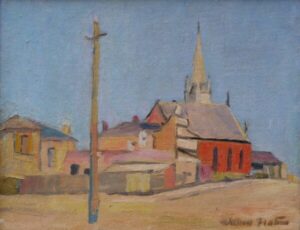Frater, William Jock (Australian / 1890-1974)
An artist and stained-glass designer, Frater was born on 31 January 1890 at Ochiltree Castle, Scotland. His father died shortly after, leaving four children to be brought up by an uncle at West Ochiltree Farm. After education at Kingscavil Primary School and Bridgend Public School, Frater studied for a year at Linlithgow Academy. Late in 1905 he accepted a three-year apprenticeship in the Glasgow glass studio of Oscar Patterson, who encouraged him to enrol at the School of Art. He won the Haldane Scholarship for drawing in 1906 and remained at the school until 1909. His ambition to become a painter was quickened by the local milieu, especially the Glasgow school's vigorous brushwork stemming from French Impressionism and the transition to the Glasgow Colourism of J. D. Ferguson and S. J. Peploe. Frater was prevented by his guardian from entering the final painting classes at the school.
Family discord caused him to migrate to Australia, arriving in Melbourne in 1910. After being refused entry to the National Gallery School he returned to Britain and in 1912-13 completed his training at Glasgow in the senior painting classes at the School of Art. In 1914 he returned to Melbourne and married Winifred Dow on 15 May 1915. In the next twenty-five years 'Jock' Frater built up a high reputation as a craftsman and stained-glass designer: Frater regarded the west window of Wesley Church, Lonsdale Street, Melbourne as his most significant design. His contribution to art in Australia was, however, as a painter who introduced Post-Impressionist principles and challenged the notion that art was an imitation of nature. Frater's oeuvre developed between 1915 and 1920 towards a simplification of design, an interplay of massed lights and shadows, and sonorous low-keyed colour that reflected his interest in the classical seventeenth century painters in interaction with the analytical tonal theory of Max Meldrum.
Notable examples of his predominantly figure and portrait paintings are 'The artist's wife reading' (1915) and 'Portrait of artist's wife' (1919). An experimental Colourist phase followed in the next decade. His first solo exhibition was held in May 1923 at the Athenaeum, Melbourne, and he exhibited with the Twenty Melbourne Painters from the late 1920s, and the Contemporary Group of Melbourne in the 1930s. In a lecture on modern art in 1925, Frater stated the basic position from which the rest of his oeuvre stems: 'Copying nature is not an art; … to copy effects of light tends to destroy form and colour'. His approach in the 1930s was markedly indebted to Cézanne, especially in the portraits which predominated until his retirement from stained-glass designing in 1940. In the next years his exploration of coastal, bushland and mining areas of Victoria provided themes for landscapes exhibited at the Contemporary Art Society, and in his solo shows at Georges Gallery, Melbourne, and the Macquarie Galleries, Sydney, in 1946. He visited Central Australia in 1950 and Port Douglas, North Queensland, in 1952. His view that great art always had qualities of disturbing strangeness was outlined in an article in Art in Australia (March 1941) and in Daub (1959-60).
His later major exhibitions were at the Australian Galleries, Melbourne, in 1958, the Victorian Artists' Society in 1963, and a retrospective at the National Gallery of Victoria in 1966. Frater was a revered president of the Victorian Artists' Society from 1963 until 1972, exhibiting annually with the society during the last decade of his career and filling three galleries at his final exhibition in July 1973. Frater gave aggressive leadership to the small group of modernists in the 1920s. His example, teaching, lecturing and crusty style of polemic did much to disrupt the academic style as the arbiter of pictorial values and to pioneer a change of taste in the community.
In 1974 Frater was appointed O.B.E. for his services to art. His work is represented in galleries and private collections throughout Australia as well as the Glasgow Art Gallery. He died at his home at Alphington on 28 November 1974 and was buried in Arthurs Creek cemetery. He was survived by four sons and a daughter.
Select Bibliography Dick Wittman, William Frater a life with colour (Melbourne University Press 2000); A. J. V. Shore, 40 Years Seek and Find (Melb, 1957); Bernard Smith, Australian Painting 1788-1960 (Melb, 1962); J. Hetherington, Australian Painters (Melb, 1963); L. Course, ‘Tradition and new accents …’, The Gallery on Eastern Hill, C. B. Christesen ed (Melb, 1970); Meanjin Quarterly, 1948 no 1; Studio (London), 1953, no 145; Herald (Melbourne), 28 Nov 1974. Author: L. J. Course Print Publication Details: L. J. Course, 'Frater, William (1890 – 1974)', Australian Dictionary of Biography, Volume 8, Melbourne University Press, 1981, pp 579-580.
Showing the single result
